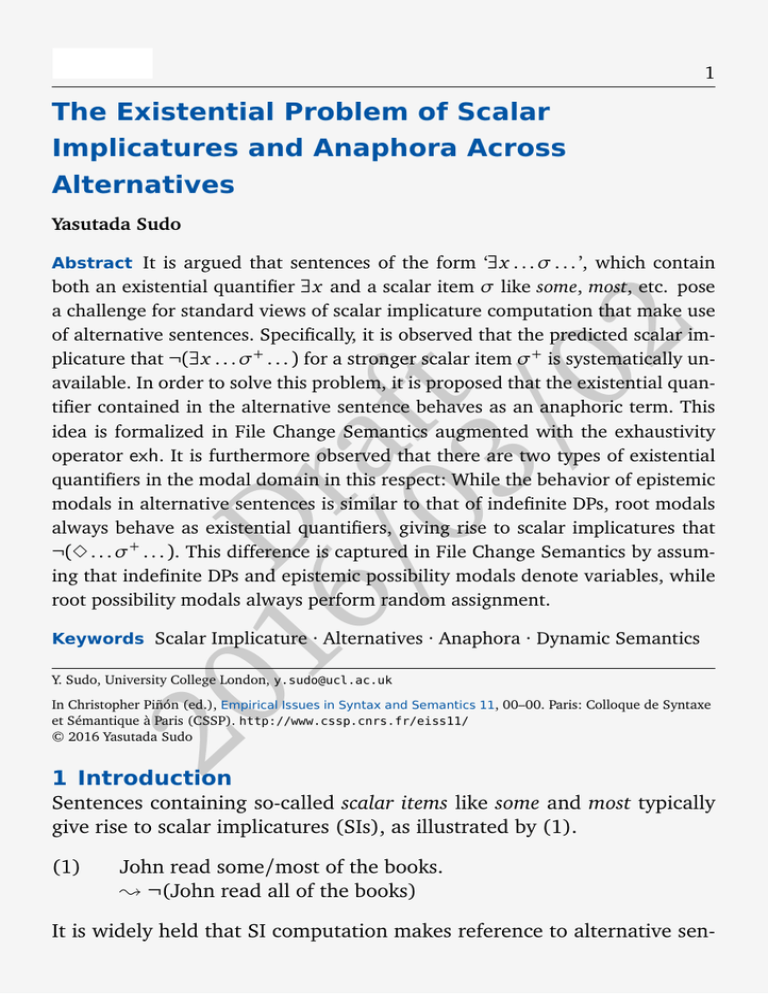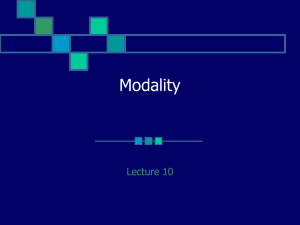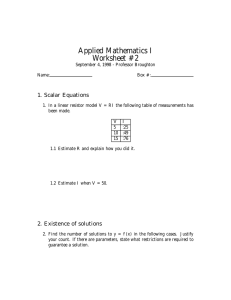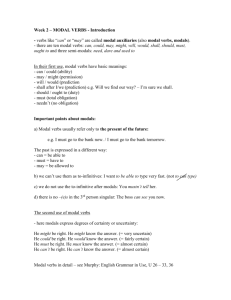The Existential Problem of Scalar Implicatures and Anaphora Across Alternatives EISS 11
advertisement

EISS 11
1
The Existential Problem of Scalar
Implicatures and Anaphora Across
Alternatives
Yasutada Sudo
Abstract It is argued that sentences of the form ‘∃x . . . σ . . . ’, which contain
D
16 r
a
/ 0 ft
3/
02
both an existential quantifier ∃x and a scalar item σ like some, most, etc. pose
a challenge for standard views of scalar implicature computation that make use
of alternative sentences. Specifically, it is observed that the predicted scalar implicature that ¬(∃x . . . σ+ . . . ) for a stronger scalar item σ+ is systematically unavailable. In order to solve this problem, it is proposed that the existential quantifier contained in the alternative sentence behaves as an anaphoric term. This
idea is formalized in File Change Semantics augmented with the exhaustivity
operator exh. It is furthermore observed that there are two types of existential
quantifiers in the modal domain in this respect: While the behavior of epistemic
modals in alternative sentences is similar to that of indefinite DPs, root modals
always behave as existential quantifiers, giving rise to scalar implicatures that
¬(3 . . . σ+ . . . ). This difference is captured in File Change Semantics by assuming that indefinite DPs and epistemic possibility modals denote variables, while
root possibility modals always perform random assignment.
Keywords Scalar Implicature · Alternatives · Anaphora · Dynamic Semantics
20
Y. Sudo, University College London, y.sudo@ucl.ac.uk
In Christopher Piñón (ed.), Empirical Issues in Syntax and Semantics 11, 00–00. Paris: Colloque de Syntaxe
et Sémantique à Paris (CSSP). http://www.cssp.cnrs.fr/eiss11/
© 2016 Yasutada Sudo
1 Introduction
Sentences containing so-called scalar items like some and most typically
give rise to scalar implicatures (SIs), as illustrated by (1).
(1)
John read some/most of the books.
; ¬(John read all of the books)
It is widely held that SI computation makes reference to alternative sen-
2
Y. Sudo
tences.1 For the sake of concreteness, I will adopt here the ‘grammatical
view’ of SI computation (Chierchia 2006, Chierchia et al. 2012, Fox 2007).
It should be stressed, however, that the same problem arises in all views
of SI computation that resort to alternative sentences.
According to the grammatical view of SIs, SIs arise via a phonologically
silent operator exh, which is often defined as follows.
(2)
Jexh(S)Kw = JS Kw ∧ ∀S 0 ∈ Alt(S)((S 9 S 0 ) → ¬JS 0 Kw )
In words, exh strengthens the meaning of the sentence S with the negation
of alternatives S 0 that are not entailed by S. For instance, for (1), exh
negates the alternative sentence in (3), which it does not enatil.
(3)
John read all of the books.
This accounts for the intuitively available SI that John did not read all of
the books.
A crucial part of this theory of SIs is the theory of alternatives. In the
above example, the SI in question is only explained under the assumption
that the sentence in (3) counts as an alternative to (2). It is, however,
beyond the scope of the present paper to thoroughly solve the vexing issue
of how exactly alternatives are constructed. Here, we simply assume with
Horn (1972) that alternatives are constructed by replacing scalar items
with their lexically specified alternatives called ‘scale mates’ (e.g. some,
most, and all are scale mates).2 This theoretical choice, however, is only
tentative, and the assumptions I will make about alternatives will not rely
crucially on lexically specified scale mates.
1
This of course does not mean that there are no theories without alternatives. See Van
Rooij & Schulz (2004), Van Rooij & Schulz (2006) and Van Rooij (2014), for example.
The problem I will discuss in this paper does not arise in these theories, but detailed
comparisons between these theories and alternative-based theories are beyond the scope
of the present paper.
2
See Katzir (2007) and Fox & Katzir (2011) for problems of this view and an alternative view, but see Breheny et al. (2016) and references therein for potential problems
for their theory.
The Existential Problem of Scalar Implicatures
3
2 The Existential Problem
A problem of the standard view of SIs arises when the sentence has the
following schematic form:3
(4)
∃x . . . some/most . . .
If we construct an alternative by replacing the scalar item some/most with
all, it will look like (5).
(5)
∃x . . . all . . .
Since this alternative is not entailed by (5), exh negates it, deriving the
SI (6).
(6)
¬(∃x . . . all . . . )
The problem, which I call the existential problem here, is that this SI is too
strong. Rather, the SI that is actually available seems to be about the same
individual that ∃x in the asserted sentence introduces. Thus, the sentence
with the SI seems to mean (7a), rather than (7b).
(7)
a.
b.
∃x(. . . some/most · · · ∧ ¬(. . . all . . . ))
∃x(. . . some/most . . . ) ∧ ¬∃x(. . . all . . . )
Here is an example illustrating this problem. As some allows an exceptional wide scope reading, which is not of our interest here, we will use
most in the examples below.
(8)
There are one or more students who read most of the books.
The problematic existential quantifier ∃ comes from one or more students
(which is assumed to have no relevant SI of its own). The alternative
sentence will look like (9).
(9)
3
There are one or more students who read all of the books.
Geurts (2008, 2009) independently notices the same problem, and makes suggestions that are closely related to what is proposed here, but he does not present a concrete
implementation, or discuss the differences among quantifiers in different domains.
4
Y. Sudo
By negating this, we obtain the SI that no student read all of the books.
Intuitively, however, this is not the SI of (9). Rather, one tends to infer
that the student who read most of the books did not read all of the books.
The same problem arises with other forms of ∃, as in (10).
(10)
a.
b.
c.
There is a student who read most of the books.
There are students who read most of the books.
There is at least one student who read most of the books.
These seem to mean (7a), rather than (7b).4
At this point one might wonder if this is really a problem, especially
given that under the approach to SIs that postulates exh, (8) is predicted
to have two possible SIs. One is what we have just derived by applying exh
to the entire sentence, but there is also another possibility where exh takes
scope within the relative clause. Since this reading corresponds to (7a),
one might think that it is fine to also derive the other reading (7b), which
is stronger, as a possible interpretation. Contrary to this, I argue that the
reading predicted with wide scope exh in fact is absent and needs to be
blocked. I make this point concrete by using two tests.
2.1 Hurford Disjunction Test
Our first test is the ‘Hurford Disjunction Test’ (HDT).5 It is known that
disjunction is infelicitous if one of the disjuncts entails the other, as in
(11) (Hurford 1974, Chierchia et al. 2012, Singh 2008).
(11)
#Either John lives in London or he lives in the UK.
Interestingly, scalar items are seemingly exempt from this constraint, as
illustrated by (12).
4
However, one needs to be cautious about other pragmatic inferences than the SI
triggered by the scalar item in question, which might lead one to conclude (7b), at least
in certain contexts. For instance, upon asked if they have good students in their class
this year, a professor could say (10a). This utterance typically triggers an inference that
the student in question is the best student they have, or perhaps the only student that is
worth mentioning in this context, from which one could conclude that the other students
didn’t do better, so none of the students read all of the books. Arguably, this is due to
other pragmatic considerations than SIs triggered by scalar items per se.
5
I thank Jacopo Romoli (p.c.) for suggesting this to me.
The Existential Problem of Scalar Implicatures
(12)
5
Either John read some of the books or he read all of them.
As suggested by Chierchia et al. (2012), one way to understand this state
of affairs is that the first disjunct of (12) can have an SI within the disjunct it is contained in, which breaks the entailment to the other disjunct
and makes the disjunction acceptable. In fact, the following sentence is
synonymous with (12) and as acceptable.
(13)
Either John read some but not all of the books or he read all of
them.
This can be used as a test for potential SIs. The logic is that if a sentence
S can have a SI that ¬S 0 and mean (S ∧ ¬S 0 ), then a disjunction of the
form ‘Either S or S 0 ’ should be felicitous. If the disjunction turns out to be
infelicitous, it suggests that ¬S 0 is unavailable as a potential SI of S.
Applying this test to the case at hand, the relevant sentence will look
like (14).
(14) ??Either there are students who read most of the books, or there
are ones who read most but not all and ones who read all.
Notice importantly that the other potential reading that there is at least
one student who read most but not all of the books doesn’t not break the
entailment here, as the same thing is asserted in the second disjunct. If
the first disjunct here could mean (7b), there wouldn’t be an entailment
from the first disjunct to the second. Thus, the infelicity indicates that the
SI that no student read all of the books is unavailable.
One important obstacle here, however, is that sentences like (14) are
mouthful and might not be easy for native speakers to judge, as the difficulty associated with the length of the sentence might make it sound
already less than perfect. Nevertheless, the contrast with (15) is suggestive, which does have the inference (7b) as an entailment due to only.
(15)
Either there are only students who read most F of the books, or
there are ones who read most but not all and ones who read all.
It seems that (14) is comparatively worse than (15), suggesting that the
reading (7b) is unavailable.
6
Y. Sudo
The difference between (14) and (15) also indicates an interesting difference between exh and only, which are often said to have very similar
semantic functions, if not completely identical (Groenendijk & Stokhof
1984, Fox & Hackl 2006, Chierchia et al. 2012). The above contrast indicates that only does negate the stronger alternative and give rise to the
reading (7b), while exh does not seem to do the same.
2.2 Question-Answer Pairs
Another test we could use to make the same point is question-answer
pairs. As illustrated by (16), SIs can be used to provide justifications for
negative answers to polar questions.
(16)
Q: Did John read all of these books?
A: He read some of them, so no.
(16A) has an SI that John did not read all of the relevant books, which
justifies the negative answer to the question.
The idea here is to set up a pragmatic context that requires the presence
of the target SI. If it is available at all, the sentence is expected to be
felicitous.
Let us apply this test to the sentence under consideration. Here too, it
is instructive to compare (17A) with the version of the sentence with only
as in (17A0 ).
(17)
Q: Did any of your students read all of the books?
A:??There are ones who read most of them, so no.
A0 : There are only ones who read most F of them, so no.
As indicated by the question marks, (17A) does not seem to be a reasonable justification for the negative answer, suggesting that it cannot have
the SI that there is none who read all of the books. On the other hand,
(17A0 ), which does have this inference as an entailment, can successfully
justify the negative answer.
3 Alternatives in File Change Semantics
The existential problem pointed out in the previous section is a general
overgeneration problem for alternative-based theories of SI computation.
The Existential Problem of Scalar Implicatures
7
I now offer a solution whose underlying idea can be implemented in most,
possibly all, of these theories, although I will stick to the framework with
exh here for expository purposes. In particular, it should be pointed out
that according to the idea proposed here, wide scope exh results in the
same reading as narrow scope exh for the problematic sentences, which
means that it does not rely on the embeddability of the SI computation
mechanism (which is unavailable under some theories).
The main ideas is the following: we do not observe the predicted SI
in sentences of the form ∃x(. . . some/most . . . ), because the existential
quantifier in the alternative behaves as an anaphoric term.6 Thus, the
only reading we can derive looks like (18a), rather than (18b). In these
representations, the second conjunct is meant to be the SI, and x in the
second conjunct of (18a) is dynamically bound by ∃x.
(18)
a.
b.
∃x(x read most of the books) ∧ ¬(x read all of the books))
∃x(x read most of the books)∧¬∃x(x read all of the books)
3.1 File Change Semantics
To flesh out this idea more concretely, I adopt File Change Semantics
(Heim 1982). A file F is a set of assignments, which are partial functions
from variables V to objects O in the model. I assume that the assignments
in a file have the same domain, and write dom(F ) for the common domain
of the assignments in F .
Variables carry two roles in this system. If a variable x is an ‘old variable’ at F (i.e. x ∈ dom(F )), it functions as an anaphor, while if it is a
‘new variable’ at F (i.e. x ∈
/ dom(F )), it effectively acts as an existential
quantifier by triggering random assignment. This is ensured by the rule
for updating the file with simple sentences. I here is the interpretation
function assigning the usual extensions to constants.
¨
{ g ∈ F | g(x) ∈ I(P 1 ) }
if x ∈ dom(F )
F [P 1 (x)] :=
0
0
0
1
{ g | ∃g ∈ F (g[x]g ∧ g (x) ∈ I(P )) } if x ∈
/ dom(F )
Here, g[x]g 0 is random assignment of a value to the variable x:
g[x]g 0 :⇔ g and g 0 differ at most in that x ∈
/ dom(g) and x ∈ dom(g 0 )
6
See Bumford (2015) and Elliott & Sudo (to appear) for related ideas.
8
Y. Sudo
More generally, for n-place predicates:
§
ª
g[x i1 ]g 0 ∧ . . . g[x im ]g 0
0 n
F [P (x 1 , . . . , x n )] := g ∃g ∈ F
∧ ⟨g 0 (x 1 ), . . . , g 0 (x n )⟩ ∈ I(P n )
for each x i j such that x i j ∈
/ dom(F )
Both indefinites and pronouns are translated into variables but indefinites are associated with a felicity condition requiring that they denote
a new variable, which is known as ‘the Novelty Condition’. Crucially, this
condition is understood to be a condition on speech act, rather than a presupposition (cf. Heim 1991, Elliott & Sudo to appear). This assumption
will become crucial when we compute alternatives.
The connectives are as in standard dynamic systems.
F [φ ∧ ψ] := F [φ][ψ]
F [¬φ] := { g ∈ F | ¬∃g 0 ∈ F [φ](g ≤ g 0 ) }
Here g ≤ g 00 :⇔ for all x ∈ dom(g), g(x) = g 0 (x).
As the scalar items in the examples in question are generalized quantifiers, I postulate dynamic selective generalized quantifiers (van Eijck &
de Vries 1992, Kanazawa 1993, 1994, Chierchia 1995). For the purposes
of the present paper, this is only for the sake of completeness, and the
particular way of implementing dynamic generalized quantifiers here is
largely inconsequential. To keep the discussion as simple as possible, I
assume that generalized quantifiers are not externally dynamic, meaning
they do not introduce new discourse referents (see van den Berg 1996,
Nouwen 2003, 2007, Brasoveanu 2007, 2010a,b for externally dynamic
generalized quantifiers).
Here are the details. Determiners are assumed to be associated with
variables (indicated by superscripts), which are assumed to be subject to
the Novelty Condition on a par with indefinties. For example, all has the
following meaning. Here g[x/o] is that assignment that differ from g at
most in that g[x/o](x) = o.
§
ª
{ o ∈ O | { g[x/o] } [φ] 6= ; }
x
(19)
F [all (φ)(ψ)] := g ∈ F ⊆ { o ∈ O | { g[x/o] } [φ][ψ] 6= ; }
The Existential Problem of Scalar Implicatures
9
More generally, the interpretation of a determiner Q in the present system
can be defined in terms of its classical counterpart Q of type ((et)((et)t))
as follows:
§
Q({ o ∈ O | { g[x/o] } [φ] 6= ; }) ª
x
(20)
F [Q (φ)(ψ)] = g ∈ F ({ o ∈ O | { g[x/o] } [φ][ψ] 6= ; })
The idea here is that the dynamic generalized quantifier Q collects the
objects that make its restrictor φ true (the ‘maxset’) and the objects that
make both its restrictor φ and nuclear scope ψ true (the ‘refset’), and applies the classical generalized quantifier Q to these two sets. The fact that
the refset refers both to the restrictor φ and nuclear scope ψ embodies
the Conservativity Universal. See the works cited above for more on this.
3.2 Anaphora in Alternatives
Coming back to SIs, I propose that exh dynamically conjoins S and its
negated alternatives. If the only relevant alternative is S 0 , then F [exh(S)] =
F [S ∧ ¬S 0 ] = F [S][¬S 0 ], for example. More generally:
F [exh(S)] = { g ∈ F [S] | ∀S 0 ∈ Alt(S)((F [S][S 0 ] ⊂ F [S]) → g ∈ F [S][¬S 0 ]) }
That is, when there are multiple alternatives to S that could have strengthened S at F , i.e. F [S][S 0 ] ⊂ F [S], then their SIs are computed in parallel.7
To see how this works concretely, let us take the sentence (8) with the
indexing as in (21a). The alternative sentence looks like (21b).
(21)
a.
b.
There is one or more x students who read most y of the books.
There is one or more x students who read allz of the books.
It is crucial that the same variable x is used on one or more in (21a) and
(21b), which is taken to be an indefinite determiner here, while the variables on the scalar items are distinct. I assume that this is ensured by
how alternatives are constructed syntactically. That is, from the sentence
(21a), the alternative (21b) is constructed by keeping everything, includ7
Alternatively, the alternatives could be ordered and used to perform sequential updates, but I don’t see any empirical reasons to favor or disfavor this possibility. I leave
this as a theoretical choice.
10
Y. Sudo
ing the indices constant, except for the scalar item and the index on it.8
The above sentences (without exh) are translated into (22), respectively.
(22)
a.
b.
student(x) ∧ most y (book( y))(read(x, y))
student(x) ∧ allz (book(z))(read(x, z))
When exh is applied to (22a), the negation of the alternative (22b) is
processed after (22a). Then, the variable x in it acts as an anaphoric term,
because x is an old variable at F [(21a)] (whenever it is not ;), although
it is new at F . Notice here that the Novelty Condition (qua a condition
on speech acts) is not violated, because x is novel at F . The resulting file,
then, is the following:
F [(22a)][¬(22b)]
g[x]g 0 ∧ g 0 (x) ∈ I(student)
∧MOST({ o ∈ O | o ∈ I(book) })
0 = g ∃g ∈ F ({ o ∈ O | o ∈ I(book) ∧ ⟨g 0 (x), o⟩ ∈ I(read) })
∧¬ALL({ o ∈ O | o ∈ I(book) })
({ o ∈ O | o ∈ I(book) ∧ ⟨g 0 (x), o⟩ ∈ I(read) })
This amounts to the following reading: there is a student x who read
at least most of the books, and it’s not the case that the same student x
read all of the books). Importantly in the present account this is the only
possible reading of the sentence, as the same SI is predicted if exh applies
within the relative clause. Thus, the problematic SI cannot be generated
here, and the existential problem does not arise.
4 Modals
So far so good. Interestingly, however, not all existential quantifiers give
rise to the existential problem. Specifically, we observe that among existential quantifiers in the modal domain, i.e. possibility modals, there are
8
Note that this does not hinge on the theory of alternatives we are tentatively adopting here. Rather, it is an additional constraint that I am unable to derive from independent principles. I believe other theories of alternatives similarly do not necessarily
predict this constraint. In fact, the structural theory of alternatives (Katzir 2007, Fox &
Katzir 2011) might allow alternatives to have different indices and overgenerate here.
The Existential Problem of Scalar Implicatures
11
ones that behave differently from indefinite DPs. That is, sentences of the
form 3(. . . some/most . . . ) where 3 is an root possibility modal do give
rise to SIs that ¬3(. . . all . . . ). To see this more concretely, consider (23),
where the relevant existential modal is the deontic possibility modal allowed.9
(23)
John is allowed to read most of the books.
; ¬(John is allowed to read all of the books)
One can infer from this sentence that John is not allowed to read all of
the books. A HDT confirms this observation.
(24)
a.
b.
Either John is allowed to read most of the books, or he can
choose whether to read most of them or all of them.
Either John is only allowed to read most of the books, or he
can choose whether to read most of them or all of them.
Both of these sentences seem to be acceptable. Similarly, the following
question-answer pair points to the same conclusion.
(25)
A: Is John allowed to read all of these books?
B: He’s allowed to read most of them, so no.
B0 : He’s only allowed to read mot of them, so no.
Other root possibility modals also give rise to SIs that ¬3(. . . all . . . ),
e.g. other deontic possibility modals, as in (26), and ability modals, as in
(27). As above, we are only interested in the narrow scope reading of the
scalar item.
(26)
a.
b.
(27)
9
a.
You may eat most of the cookies.
; ¬(You may eat all of the cookies)
You can keep most of this money.
; ¬(You can keep all of this money)
I can read most of these papers by tomorrow.
; ¬(I can read all of these papers by tomorrow)
(23) has more SIs, which is due to the fact that allowed is also a scalar item. We
will not discuss these SIs to simplify the discussion. See Fox (2007), Chemla (2009) and
Romoli (2012).
12
Y. Sudo
b.
John is able to finish some of the work.
; ¬(John is able to finish all of the work)
It is furthermore observed that there is variation among modals. Specifically, epistemic possibility modals differ from root possibility modals in
this respect, and patter with indefinite DPs. For example, (28) do not seem
to have the SI ¬3(. . . all . . . ), i.e. they do not have SIs to the effect that the
speaker considers it impossible that John read all of these books. Rather,
the intuitively available reading is one where the SI seemingly takes scope
below the modal.
(28)
a.
b.
John might have read most of these books.
It is possible that John read most of these books.
This is confirmed with a HDT as in (29), and a question-answer pair test
as in (30).10
(29)
#Either John might have read most of these books, or all we know
is that he read at least most, possibly all of them.
(30)
Q: Do you think it’s possible that John read all of the books?
A: #He might have read most of them, so no.
To summarize the observations, indefinite DPs and epistemic possibility modals do not give rise to SIs that involve negated existential quantifiers, while root possibility modals do. In order to account for this difference, I claim that indefinite DPs and epistemic possibility modals denote
variables, while root possibility modals are always interpreted as existential quantifiers, even in alternatives. I will demonstrate below that File
Change Semantics offers a way to model this difference.
4.1 Epistemic Modals
Let us first tackle epistemic possibility modals, which work like indefinite
DPs with respect to the existential problem of SIs.
It is known that modals have anaphoric properties, just like quantifi10
One important confound here, however, is that corresponding sentences with overt
only cannot be constructed, due to restrictions on the scope of only relative to epistemic
modals. Yet, the judgments seem to be reasonably robust.
The Existential Problem of Scalar Implicatures
13
cational DPs. Anaphora in the modal domain is often discussed under the
rubric of modal subordination (Roberts 1987, Geurts 1999, Stone 1999,
Brasoveanu 2007, 2010a,b, Sudo 2014).11 The phenomenon of modal
subordination itself is not of particular interest here, but to illustrate, consider (31).
(31)
John might come. John would bring a bottle of sake with him.
The meaning of the second sentence of (31) is depending on might in
the first sentence: might introduces the possibility that John will come,
and the second sentence elaborates on this possibility by saying that if he
comes he will bring a bottle of sake with him.
There are several theories of modal subordination in the literature,
but I adopt here the idea of Stone (1999) and Brasoveanu (2010a) and
postulate variables over sets of possible worlds (see also Sudo 2014). The
theoretical choice here is largely arbitrary, however, and as far as I can
see, nothing in the idea below crucially relies on this theory of modal
subordination. That is, the only crucial part of the idea is that might is an
indefinite in the modal domain.12
Let us see a concrete example. The first conjunct of (31), for example,
can be given the following meaning, where ω is a variable over sets of
possible worlds, functioning as the modal base for the epistemic modal.
We assume John is a rigid designator denoting j, and assignments are
functions from variables over objects Vo and variables over sets of possible worlds Vw to objects O and possible worlds W. In addition, I is
parametrized to a possible world. Doxs is the set of doxastic alternatives
for the speaker. As with indefinite DPs, I assume that might is subject to
the Novelty Condition, requiring at the speech act level that it introduce
a new discourse referent.
(32)
11
F [mightω (come( j))]
The term modal subordination is often used to refer also to pronominal anaphora
mediated by modal anaphora, e.g. John might bring a bottle of sake with him. But he
wouldn’t share it with us. Such complex cases are not of our concern here.
12
This, however, means that we could not use the theory of epistemic modals as tests
due to Veltman (1996).
14
Y. Sudo
{¨g ∈F | ∃w ∈ g(ω)( j ∈ Iw (come)) }
«
0
0
=
∃g
∈
F
(g[ω]g
∧
g
(ω)
⊆
Dox
s
0
g ∧∀w ∈ g(ω)( j ∈ I (come))
w
if ω ∈ dom(F )
if ω ∈
/ dom(F )
In order for this analysis to be completely, some presuppositions need to
be added. For instance, whenever old, ω should be a set of epistemic possibilities, rather than any set of possible worlds. One could also state the
meaning of mood as a presupposition, e.g. indicative mood presupposes
that the actual world might be in ω. To avoid unnecessary clutter, I will
omit these presuppositions here.
The important aspect of this analysis is that might introduces a new set
of epistemic possibilities, which later sentences can anaphorically refer
back to. In the above example, would refers to the possibilities that John
will come and discard all the assignments but g such that in all w ∈ g(ω)
John will bring a bottle of sake in w.
(33)
F [wouldω (sake(x) ∧ bring( j, x))]
= { g ∈ F | ∀w ∈ g(ω)(g(x) ∈ Iw (sake) ∧ ⟨ j, g(x)⟩ ∈ Iw (bring)) }
Let us now combine this analysis of epistemic modals and our analysis
of SIs developed in the previous section. Sentences like (28) above are,
then, predicted to lack SIs of the form (7b), on the assumption that the
variable associated with the epistemic possibility modal stays the same in
the alternative. This is shown more concretely in (34)
(34)
F [exh(mightω (most x (book(x))(read(x, j))))]
= F [mightω (most x (book(x))(read(x, j)))]
[¬(mightω (all y (books)(λx.read( j)(x))))]
As in the case of indefinite DPs, it is crucial that might in the asserted
sentence has a new variable ω, and the same variable ω appears on might
in the alternative. This is again assumed to be ensured by the syntax of
The Existential Problem of Scalar Implicatures
15
alternatives. (34) will result in the following set of assignments.
g[ω]g 0 ∧ g 0 (ω) ⊆ Doxs
∧∀w ∈ g 0 (ω)(MOST({ o ∈ O | o ∈ Iw (book) })
0 g ∃g ∈ F ({ o ∈ O | o ∈ Iw (book) ∧ ⟨ j, o⟩ ∈ Iw (read) }))
∧¬∀w ∈ g 0 (ω)(ALL({ o ∈ O | o ∈ I (book) })
w
({ o ∈ O | o ∈ I (book) ∧ ⟨ j, o⟩ ∈ I (read) }))
w
w
In words, there is an epistemic possibility that John read most of the books
where it is not the case that John read all of the books.13 The SI here therefore corresponds to (7a), and the SI of the form (7b) cannot be derived
in the present system.
4.2 Root Modals
Now, what about root possibility modals, which do give rise to SIs that
¬3(. . . all . . . ), unlike epistemic modals and indefinite DPs? Although I do
not have a satisfactory answer at the moment as to why root modals are
different in this particular way from epistemic modals, the framework we
are assuming at least offers a way to capture their behavior. Specifically, I
propose that unlike epistemic possibility modals, root possibility modals
always perform random assignment. This is shown by (35) for deontic
possibility, where DEON is the set of deontically ideal worlds.14
(35)
ω
F [allowed
(come( j))]
ª
§ ∃g
∈ F (g[ω]g 0 ∧ g 0 (ω) ⊆ DEON
0 = g ∧∀w ∈ g(ω)( j ∈ Iw (come))
This meaning will derive the desired reading for (23) that John is allowed
to read most of the books and he is not allowed to read all of the books,
13
In the above representation, ¬ is taking scope over the universal quantification over
possible worlds, which is arguably too weak. However, assuming that this universal
quantification is associated with a homogeneity requirement, the SI becomes adequately
strong. This assumption is justifiable, as the universal quantifier here is due to plural
predication of possible worlds and plural predication in natural language generally gives
rise to homogeneity effects.
14
This of course is a gross oversimplification of the meaning of deontic modals. See
Kratzer (1981, 1991) in particular. Although I do not see any obstacle in adopting Kratrzer’s ideas in our current framework, I will assume the simplistic semantics here too
keep the exposition simple.
16
Y. Sudo
which involves an SI of the form (7b). More specifically, after processing
the asserted sentence John is allowedω to read most of the books against
file F , we obtain the following file F 0 :
g[ω]g 0 ∧ g 0 (ω) ⊆ DEON
0
0
0
F = g ∃g ∈ F ∧∀w ∈ g (ω)(MOST({ o ∈ O | o ∈ Iw (book) })
({ o ∈ O | o ∈ Iw (book) ∧ ⟨ j, o⟩ ∈ Iw (read) }))
Now we process the negation of the alternative sentence John is allowedω
to read all of the books, and obtain the following file:
0
00
00
g
[ω]g
∧
g
(ω)
⊆
DEON
00
0
0 00
∧∀w ∈ g (ω)(ALL({ o ∈ O | o ∈ Iw (book) })
g ∈ F ¬∃g
({ o ∈ O | o ∈ Iw (book) ∧ ⟨ j, o⟩ ∈ Iw (read) }))
Importantly, ω here is again used to perform random assignment. Consequently, each g 0 in this file maps ω to a set of deontically ideal worlds in
which John reads most of the books, and additionally, it is ensured that
there’s no way to assign ω a set of deontically ideal worlds in which John
reads all of the books, because such assignments are culled out by the
SI.15
5 Conclusions and Further Issues
In the present paper I have made two main observations: (i) sentences
of the form ‘∃ . . . some/most . . . ’ where ∃ is an indefinite DP or an epistemic possibility modal lack the negation of ‘∃ . . . all . . . ’ as a (potential)
SI, but (ii) this SI is observed when ∃ is a root modal. To account for (i),
I pursued the following idea: indefinites DPs and epistemic modals denote variables, which introduce new discourse referents in the asserted
sentence but behave as anaphoric terms in the negated alternative sentences. As for the issue (ii), I proposed that root possibility modals do not
15
If one believes that the embedded SI is also available for sentences like (23), one
could resort to one’s favorite way of accounting for embedded SIs. In the current set
up, exh can simply take scope in the infinitival clause to yield this reading. Since the
availability of embedded SIs is not the main concern of the present paper, I will remain
uncommitted to this issue here.
The Existential Problem of Scalar Implicatures
17
denote variables, but existential quantifiers and always perform random
assignment.
Admittedly, this account of (ii) is still preliminary, as it is essentially
a lexical stipulation made just to account for what is observed and lacks
independent justification. Differences between epistemic vs. root modals
are a very well discussed topic (cf. Ross 1969, Perlmutter 1971, Jackendoff
1972, Brennan 1993, von Fintel & Iatridou 2003, Hacquard 2006, 2011),
and I hope the present analysis will eventually relate to the insights offered by this body of literature, and lead to a deeper explanation of their
syntax and semantics. This issue is left for future research.
Another remaining issue that is set aside in the present paper is the
interactions between SIs and other types of quantifiers than indefinites.
That is, it is natural to extend the ideas of the present paper to sentences
like the following.
(36)
a.
b.
20% of the students read most of the books.
Most of the students read most of the books.
(37)
a.
b.
John is likely to have read most of the books.
John has probably read most of the books.
The reason why I am not discuss these cases here is because those quantifiers come with their own SIs, giving rise to independent problems of
multiple scalar items discussed by Fox (2007), Chemla (2009) and Romoli
(2012) (as mentioned already in fn.9). It is expected that the perspective
of the present dynamic semantic account provides new insights into this
issue, which is left for another occasion.
Acknowledgments I would like to thank Sam Alxatib, Richard Breheny, Nathan
Klinedinst, Andreea Nicolae, Rick Nouwen, Jacopo Romoli, and Daniel Rothschild, and the audience at the London Semantics Day in May 2015 for helpful
discussion and criticisms on the material presented here. All errors are my own.
References
van den Berg, Martin. 1996. Some Aspects of the Internal Structure of Discourse:
The Dynamics of Nominal Anaphora: Universiteit van Amsterdam Ph.D. dissertation.
18
Y. Sudo
Brasoveanu, Adrian. 2007. Structured Nominal and Modal Reference: Rutgers
University Ph.D. dissertation.
Brasoveanu, Adrian. 2010a. Decomposing modal quantification. Journal of Semantics 27(4). 1–91. doi:10.1093/jos/ffq008.
Brasoveanu, Adrian. 2010b. Structured anaphora to quantifier domains. Information and Computation 208(12). 450–473. doi:10.1016/j.ic.2008.10.007.
Breheny, Richard, Nathan Klinedinst, Jacopo Romoli & Yasutada Sudo. 2016.
Does the structural approach to alternatives give us just enough alternatives
to solve the symmetry problem? Ms., University College London and Ulster
University.
Brennan, Virginia. 1993. Root and Epistemic Modal Auxiliary Verbs: University of
Massachusetts, Amherst dissertation.
Bumford, Dylan. 2015. Incremental quantification and the dynamics of pair-list
phenomena. Semantics & Pragmatics 8(9). 1–70.
Chemla, Emmanuel. 2009. Similarity: towards a unified account of scalar implicatures, free choice permission and presupposition projection. Ms.
Chierchia, Gennaro. 1995. Dynamics of Meaning: Anaphora, Presupposition, and
the Theory of Grammar. Chicago: University of Chicago Press.
Chierchia, Gennaro. 2006. Broaden your views: Implicatures of domain widening and the “Logicality” of language. Linguistic Inquiry 37(4). 535–590.
Chierchia, Gennaro, Danny Fox & Benjamin Spector. 2012. Scalar implicature
as a grammatical phenomenon. In Claudia Maienborn, Klaus von Heusinger
& Paul Portner (eds.), Semantics: An International Handbook of Natural Language Meaning, 2297–2331. Berlin: de Gruyter.
Elliott, Patrick D. & Yasutada Sudo. to appear. E-type readings of quantifiers
under ellipsis. In Proceedings of Sinn und Bedeutung 20, .
von Fintel, Kai & Sabine Iatridou. 2003. Epistemic containment. Linguistic Inquiry 34(2). 173–198. doi:10.1162/002438903321663370.
Fox, Danny. 2007. Free choice and the theory of scalar implicatures. In Uli Sauerland & Penka Stateva (eds.), Presupposition and Implicature in Compositional
Semantics, 71–112. Palgrave Macmillan.
Fox, Danny & Martin Hackl. 2006. The universal density of measurement. Linguistics and Philosophy 29(5). 537–586. doi:10.1007/s10988-006-9004-4.
Fox, Danny & Roni Katzir. 2011. On the characterization of alternatives. Natural
Language Semantics 19(1). 87–107. doi:10.1007/s11050-010-9065-3.
Geurts, Bart. 1999. Presuppositions and Pronouns. Amsterdam: Elsevier.
Geurts, Bart. 2008. Implicture as a discourse phenomenon. In Proceedings of
Sinn und Bedeutung 11, 261–275.
The Existential Problem of Scalar Implicatures
19
Geurts, Bart. 2009. Scalar implicature and local pragmatics. Mind & Language
24(1). 51–79. doi:10.1111/j.1468-0017.2008.01353.x.
Groenendijk, Jeroen & Martin Stokhof. 1984. Studies on the Semantics of Questions and the Pragmatics of Answers: University of Amsterdam dissertation.
Hacquard, Valentine. 2006. Aspects of Modality: Massachusetts Institute of Technology dissertation.
Hacquard, Valentine. 2011. Modality. In Klaus von Heusinger, Claudia Maienborn & Paul Portner (eds.), Semantics: An International Handbook of Natural
Language Meaning, vol. 2, 1484–1515. Berlin: de Gruyter.
Heim, Irene. 1982. The Semantics of Definite and Indefinite Noun Phrases: University of Massachusetts, Amherst Ph.D. dissertation.
Heim, Irene. 1991. Artikel und Definitheit. In Arnim von Stechow & Dieter Wunderlich (eds.), Semantik: Ein internationales Handbuch der zeitgenössischen
Forschung/Semantics: An International Handbook of Contemporary Research,
487–535. Berlin: de Gruyter.
Horn, Laurence. 1972. On the Semantic Properties of the Logical Operators: University of California Los Angeles dissertation.
Hurford, James R. 1974. Exclusive or inclusive disjunction. Foundations of Language 11(3). 409–411.
Jackendoff, Ray. 1972. Semantic Interpretation in Generative Grammar. Cambridge, MA: MIT Press.
Kanazawa, Makoto. 1993. Dynamic generalized quantifiers and monotonicity.
Tech. rep. ILLC.
Kanazawa, Makoto. 1994. Weak vs. strong readings of donkey sentences and
monotonicity inferences in a dynamic setting. Linguistics and Philosophy
17(2). 109–158. doi:10.1007/BF00984775.
Katzir, Roni. 2007. Structurally-defined alternatives. Linguistics and Philosophy
30(6). 669–690. doi:10.1007/s10988-008-9029-y.
Kratzer, Angelika. 1981. The notional category of modality. In Hans-Jürgen Eikmeyer & Hannes Rieser (eds.), Words, Worlds, and Contexts, 38–74. Berlin:
de Gruyter.
Kratzer, Angelika. 1991. Modality. In Arnim von Stechow & Dieter Wunderlich (eds.), Semantik: Ein internationales Handbuch der zeitgenössischen
Forschung/Semantics: An International Handbook of Contemporary Research,
639–650. Berlin: de Gruyter.
Nouwen, Rick. 2003. Complement anaphora and interpretation. Journal of Semantics 20(1). 73–113.
Nouwen, Rick. 2007. On dependent pronouns and dynamic semantics. Journal
20
Y. Sudo
of Philosophical Logic 36(2). 123–154. doi:10.1007/s10992-006-9029-8.
Perlmutter, David. 1971. Deep and Surface Structure Constraints in Syntax. New
York: Holt, Rinehart, and Winston.
Roberts, Craige. 1987. Modal Subordination, Anaphora and Distributivity: University of Massachusetts, Amherst Ph.D. dissertation.
Romoli, Jacopo. 2012. Soft But Strong: Neg-Raising, Soft Triggers, and Exhaustification: Harvard University dissertation.
van Rooij, Robert. 2014. A fine-grained global analysis of implicatures. Ms.,
Universiteit van Amsterdam.
van Rooij, Robert & Katrin Schulz. 2004. Exhaustive interpretation of complex
sentences. Journal of Logic, Language and Information 13(4). 491–519.
van Rooij, Robert & Katrin Schulz. 2006. Pragmatic meaning and non-monotonic
reasoning: The case of exhaustive interpretation. Linguistics and Philosophy
29(2). 205–250. doi:10.1007/s10988-005-3760-4.
Ross, John. 1969. Auxiliaries as main verbs. In William Todd (ed.), Studies in
Philosophical Linguistics I, 77–102. Evanston, IL: Great Expectations Press.
Singh, Raj. 2008. On the interpretation of disjunction: asymmetric, incremental,
and eager for inconsistency. Linguistics and Philosophy 31(2). 245–260. doi:
10.1007/s10988-008-9038-x.
Stone, Matthew. 1999. Reference to possible worlds. RuCCS Report 49 Rutgers
University.
Sudo, Yasutada. 2014. Presupposition satisfaction in attitude contexts. In Luka
Crnič & Uli Sauerland (eds.), The Art and Craft of Semantics: A Festschrift for
Irene Heim, vol. 2, 175–199. MITWPL.
van Eijck, Jan & Fer-Jan de Vries. 1992. Dynamic interpretation and Hoare
deduction. Journal of Logic, Language and Information 1(1). 1–44. doi:
10.1007/BF00203385.
Veltman, Frank. 1996. Defaults in update semantics. Journal of Philosophical
Logic 25(3). 221–261. doi:10.1007/BF00248150.







